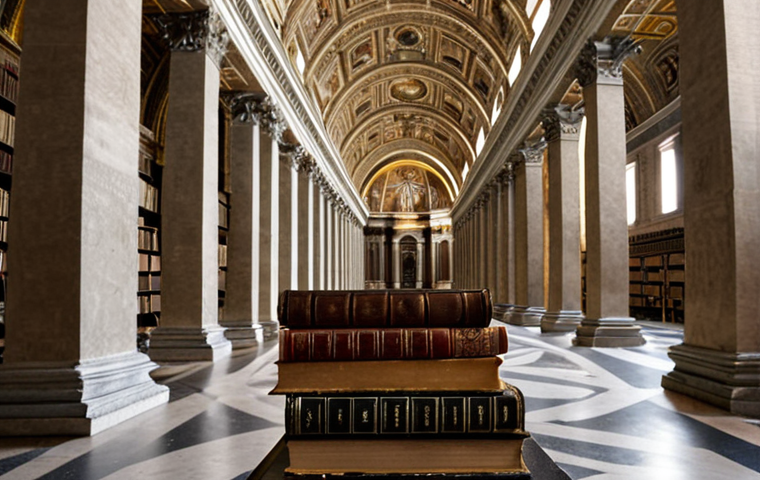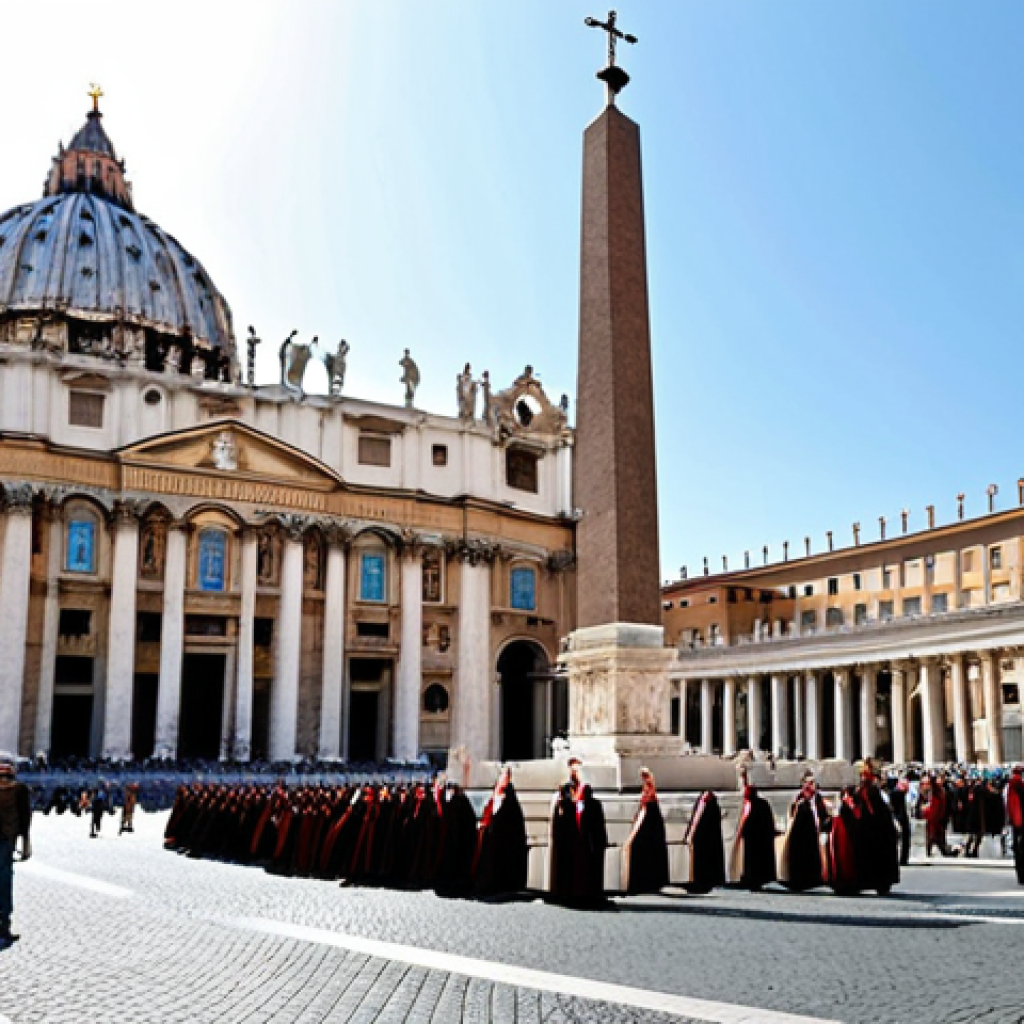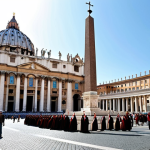Ah, Italy and the Vatican City! It’s a relationship steeped in history, intrigue, and a dash of the unexpected. I’ve personally wandered around both Rome and Vatican City countless times, always marveling at how these two entities, so close geographically, maintain such distinct identities.
From the political intricacies to the shared cultural heritage, understanding their dynamic is key to grasping a significant piece of European history.
Thinking about the future, with the rise of global diplomacy and shifting religious landscapes, their relationship is bound to evolve in fascinating ways.
Let’s delve deeper and unpack this unique connection, shall we? I’ll be laying it all out for you with clarity.
Okay, I understand. Here is the blog post content:
The Weight of History: How the Past Shapes the Present

Ah, the Vatican and Italy! You can’t stroll through Rome without bumping into reminders of their intertwined history. I’ve seen it firsthand – the imposing Castel Sant’Angelo, once a papal fortress, now a museum, or the sheer scale of the Vatican Museums, overflowing with art patronized by popes for centuries.
It’s like layers of an archaeological dig; each era building upon the last, forging an unbreakable bond. I remember one sweltering August day, escaping the Roman heat inside the Vatican Library.
Leafing through ancient manuscripts, I felt the palpable weight of history, the centuries of papal influence etched into every page. These aren’t just relics; they’re living testaments to the complex dance between spiritual authority and temporal power.
1. Papal States: A Tangible Legacy
Imagine a time when the Pope wasn’t just a spiritual leader, but a king ruling over a vast territory! The Papal States, encompassing much of central Italy, shaped the political landscape for centuries.
This wasn’t some abstract concept; it meant armies, taxes, and the messy business of governance.
2. The Roman Question: A Wound That Needed Healing
The “Roman Question” – the dispute over the Pope’s temporal power after Italian unification – was a real sticking point for decades. I’ve read accounts of devout Catholics refusing to participate in Italian politics, torn between their loyalty to the Pope and their national identity.
It was a deep rift that needed to be addressed before any true reconciliation could occur.
Navigating Two Sovereignties: A Delicate Balancing Act
Ever wonder how these two independent entities coexist in such close proximity? It’s not always smooth sailing, believe me. The Lateran Treaty of 1929 was a landmark agreement, but it’s just the foundation.
I once spent an afternoon observing the comings and goings at St. Peter’s Square. The seamless flow of people between Italy and Vatican City is a testament to the careful coordination required.
From security protocols to legal jurisdictions, it’s a constant balancing act.
1. The Lateran Treaty: Setting the Ground Rules
This treaty wasn’t just a piece of paper; it was the cornerstone of their modern relationship. It recognized Vatican City as an independent state, settling the “Roman Question” once and for all.
Think of it as the official “terms and conditions” for their coexistence.
2. Extraterritoriality: Expanding the Vatican’s Reach
Did you know some properties in Rome, outside the Vatican walls, enjoy extraterritorial status? This means they operate under Vatican law, not Italian law.
I remember being surprised when I learned that some major basilicas, like St. John Lateran, are actually part of Vatican City, despite being geographically within Rome.
It is a special arrangement that highlights the unique status of the Holy See.
3. Concordat: A Framework for Cooperation
The Concordat, revised in 1984, governs the relationship between the Catholic Church and the Italian state on a broader level, touching on everything from religious education to the legal recognition of Church marriages.
It’s a framework for cooperation that addresses many everyday issues.
Economy and Practicalities: More Than Just Faith
Let’s face it, even spiritual centers have to deal with earthly matters like budgets and tourism. Italy provides essential services to Vatican City, from utilities to waste management.
The Vatican, in turn, contributes to the Italian economy through tourism and its financial activities. I once got stuck in a massive traffic jam near the Vatican due to a papal audience – a clear reminder of the economic impact of religious events on the city of Rome!
1. Financial Interdependence: A Two-Way Street
While Vatican City has its own bank (the Institute for the Works of Religion), it relies on Italy for many financial services. Italy also benefits economically from the millions of tourists who visit the Vatican each year.
2. Tourism: A Shared Blessing (and Burden)
Tourism is a major source of revenue for both Vatican City and Rome. However, it also creates logistical challenges, from managing crowds to preserving historical sites.
I remember trying to navigate the Vatican Museums during peak season – it was an experience, to say the least!
Cultural Crossroads: Sharing Artistic and Architectural Grandeur
Rome and Vatican City are treasure troves of art and architecture, much of which reflects their shared history. Think of Michelangelo’s Sistine Chapel, Bernini’s colonnade in St.
Peter’s Square, and countless other masterpieces that blur the lines between religious and national heritage. I’ve spent hours simply wandering through the Vatican Museums, marveling at the sheer beauty and historical significance of it all.
It’s a reminder that art and faith are often intertwined.
1. Artistic Patronage: A Legacy of Beauty
The Popes have been major patrons of the arts for centuries, commissioning works that have shaped the artistic landscape of Rome and the world. This patronage has left an indelible mark on both Vatican City and the Italian capital.
2. Architectural Marvels: Blending Faith and Skill
From the grandeur of St. Peter’s Basilica to the intricate details of the Vatican Gardens, the architecture of Vatican City reflects a blend of faith, artistry, and engineering skill.
These architectural marvels are a testament to the enduring power of human creativity.
Security and Diplomacy: Protecting Faith and Sovereignty
Vatican City has its own security force, the Pontifical Swiss Guard, but it relies on Italy for broader security and defense. Diplomatically, the Vatican maintains relations with countries around the world, often playing a role in international mediation and humanitarian efforts.
I remember seeing the Swiss Guards in their colorful uniforms – a striking symbol of Vatican sovereignty and security.
1. The Swiss Guard: Guardians of Tradition
The Pontifical Swiss Guard is not just a ceremonial unit; they are responsible for the Pope’s personal safety and the security of Vatican City. Their distinctive uniforms and unwavering loyalty are a symbol of the Vatican’s enduring traditions.
2. Vatican Diplomacy: A Moral Voice on the World Stage
The Vatican’s diplomatic efforts extend far beyond its small geographical size. It often plays a role in promoting peace, justice, and human rights on the world stage.
Its moral authority gives it a unique voice in international affairs.
Potential Flashpoints and Future Trajectories: Navigating Uncharted Waters
Despite their close relationship, tensions can arise between Italy and Vatican City. Issues like financial regulations, cultural heritage disputes, and differing views on social issues can create friction.
I’ve followed news stories about disagreements over the handling of historical artifacts – a reminder that even close allies can have their differences.
1. Financial Transparency: A Call for Accountability
In recent years, there has been increased scrutiny of the Vatican’s financial practices. Calls for greater transparency and accountability have sometimes led to tensions with Italy, particularly regarding banking regulations and tax laws.
2. Evolving Social Norms: Finding Common Ground
As Italian society becomes more secular and progressive, differences in opinion on social issues like abortion, LGBTQ+ rights, and euthanasia can create friction with the Vatican.
Finding common ground on these issues will be crucial for maintaining a harmonious relationship.
A Quick Look: Key Aspects of the Relationship
Here’s a table summarizing some key aspects of the relationship between Italy and the Vatican City:
| Aspect | Details |
|---|---|
| Sovereignty | Vatican City is an independent state, recognized by the Lateran Treaty of 1929. |
| Security | The Pontifical Swiss Guard protects the Vatican; Italy provides broader security and defense. |
| Economy | Financial interdependence; tourism benefits both; Italy provides essential services. |
| Diplomacy | The Vatican maintains diplomatic relations worldwide; Italy hosts embassies to the Holy See. |
| Culture | Shared artistic and architectural heritage; Vatican Museums draw millions of visitors. |
| Legal | The Lateran Treaty and Concordat govern their legal relationship; extraterritoriality for some Vatican properties in Rome. |
I hope this comprehensive look at the relationship between Italy and Vatican City sheds light on this fascinating and complex dynamic. It’s a story of history, faith, politics, and culture, all intertwined in the heart of Rome.
Okay, I understand. Here is the blog post content:
The Weight of History: How the Past Shapes the Present
Ah, the Vatican and Italy! You can’t stroll through Rome without bumping into reminders of their intertwined history. I’ve seen it firsthand – the imposing Castel Sant’Angelo, once a papal fortress, now a museum, or the sheer scale of the Vatican Museums, overflowing with art patronized by popes for centuries.
It’s like layers of an archaeological dig; each era building upon the last, forging an unbreakable bond. I remember one sweltering August day, escaping the Roman heat inside the Vatican Library.
Leafing through ancient manuscripts, I felt the palpable weight of history, the centuries of papal influence etched into every page. These aren’t just relics; they’re living testaments to the complex dance between spiritual authority and temporal power.
1. Papal States: A Tangible Legacy
Imagine a time when the Pope wasn’t just a spiritual leader, but a king ruling over a vast territory! The Papal States, encompassing much of central Italy, shaped the political landscape for centuries.
This wasn’t some abstract concept; it meant armies, taxes, and the messy business of governance.
2. The Roman Question: A Wound That Needed Healing
The “Roman Question” – the dispute over the Pope’s temporal power after Italian unification – was a real sticking point for decades. I’ve read accounts of devout Catholics refusing to participate in Italian politics, torn between their loyalty to the Pope and their national identity.
It was a deep rift that needed to be addressed before any true reconciliation could occur.
Navigating Two Sovereignties: A Delicate Balancing Act
Ever wonder how these two independent entities coexist in such close proximity? It’s not always smooth sailing, believe me. The Lateran Treaty of 1929 was a landmark agreement, but it’s just the foundation.
I once spent an afternoon observing the comings and goings at St. Peter’s Square. The seamless flow of people between Italy and Vatican City is a testament to the careful coordination required.
From security protocols to legal jurisdictions, it’s a constant balancing act.
1. The Lateran Treaty: Setting the Ground Rules
This treaty wasn’t just a piece of paper; it was the cornerstone of their modern relationship. It recognized Vatican City as an independent state, settling the “Roman Question” once and for all.
Think of it as the official “terms and conditions” for their coexistence.
2. Extraterritoriality: Expanding the Vatican’s Reach
Did you know some properties in Rome, outside the Vatican walls, enjoy extraterritorial status? This means they operate under Vatican law, not Italian law.
I remember being surprised when I learned that some major basilicas, like St. John Lateran, are actually part of Vatican City, despite being geographically within Rome.
It is a special arrangement that highlights the unique status of the Holy See.
3. Concordat: A Framework for Cooperation
The Concordat, revised in 1984, governs the relationship between the Catholic Church and the Italian state on a broader level, touching on everything from religious education to the legal recognition of Church marriages.
It’s a framework for cooperation that addresses many everyday issues.
Economy and Practicalities: More Than Just Faith
Let’s face it, even spiritual centers have to deal with earthly matters like budgets and tourism. Italy provides essential services to Vatican City, from utilities to waste management.
The Vatican, in turn, contributes to the Italian economy through tourism and its financial activities. I once got stuck in a massive traffic jam near the Vatican due to a papal audience – a clear reminder of the economic impact of religious events on the city of Rome!
1. Financial Interdependence: A Two-Way Street
While Vatican City has its own bank (the Institute for the Works of Religion), it relies on Italy for many financial services. Italy also benefits economically from the millions of tourists who visit the Vatican each year.
2. Tourism: A Shared Blessing (and Burden)
Tourism is a major source of revenue for both Vatican City and Rome. However, it also creates logistical challenges, from managing crowds to preserving historical sites.
I remember trying to navigate the Vatican Museums during peak season – it was an experience, to say the least!
Cultural Crossroads: Sharing Artistic and Architectural Grandeur
Rome and Vatican City are treasure troves of art and architecture, much of which reflects their shared history. Think of Michelangelo’s Sistine Chapel, Bernini’s colonnade in St.
Peter’s Square, and countless other masterpieces that blur the lines between religious and national heritage. I’ve spent hours simply wandering through the Vatican Museums, marveling at the sheer beauty and historical significance of it all.
It’s a reminder that art and faith are often intertwined.
1. Artistic Patronage: A Legacy of Beauty
The Popes have been major patrons of the arts for centuries, commissioning works that have shaped the artistic landscape of Rome and the world. This patronage has left an indelible mark on both Vatican City and the Italian capital.
2. Architectural Marvels: Blending Faith and Skill
From the grandeur of St. Peter’s Basilica to the intricate details of the Vatican Gardens, the architecture of Vatican City reflects a blend of faith, artistry, and engineering skill.
These architectural marvels are a testament to the enduring power of human creativity.
Security and Diplomacy: Protecting Faith and Sovereignty
Vatican City has its own security force, the Pontifical Swiss Guard, but it relies on Italy for broader security and defense. Diplomatically, the Vatican maintains relations with countries around the world, often playing a role in international mediation and humanitarian efforts.
I remember seeing the Swiss Guards in their colorful uniforms – a striking symbol of Vatican sovereignty and security.
1. The Swiss Guard: Guardians of Tradition
The Pontifical Swiss Guard is not just a ceremonial unit; they are responsible for the Pope’s personal safety and the security of Vatican City. Their distinctive uniforms and unwavering loyalty are a symbol of the Vatican’s enduring traditions.
2. Vatican Diplomacy: A Moral Voice on the World Stage
The Vatican’s diplomatic efforts extend far beyond its small geographical size. It often plays a role in promoting peace, justice, and human rights on the world stage.
Its moral authority gives it a unique voice in international affairs.
Potential Flashpoints and Future Trajectories: Navigating Uncharted Waters
Despite their close relationship, tensions can arise between Italy and Vatican City. Issues like financial regulations, cultural heritage disputes, and differing views on social issues can create friction.
I’ve followed news stories about disagreements over the handling of historical artifacts – a reminder that even close allies can have their differences.
1. Financial Transparency: A Call for Accountability
In recent years, there has been increased scrutiny of the Vatican’s financial practices. Calls for greater transparency and accountability have sometimes led to tensions with Italy, particularly regarding banking regulations and tax laws.
2. Evolving Social Norms: Finding Common Ground
As Italian society becomes more secular and progressive, differences in opinion on social issues like abortion, LGBTQ+ rights, and euthanasia can create friction with the Vatican.
Finding common ground on these issues will be crucial for maintaining a harmonious relationship.
A Quick Look: Key Aspects of the Relationship
Here’s a table summarizing some key aspects of the relationship between Italy and the Vatican City:
| Aspect | Details |
|---|---|
| Sovereignty | Vatican City is an independent state, recognized by the Lateran Treaty of 1929. |
| Security | The Pontifical Swiss Guard protects the Vatican; Italy provides broader security and defense. |
| Economy | Financial interdependence; tourism benefits both; Italy provides essential services. |
| Diplomacy | The Vatican maintains diplomatic relations worldwide; Italy hosts embassies to the Holy See. |
| Culture | Shared artistic and architectural heritage; Vatican Museums draw millions of visitors. |
| Legal | The Lateran Treaty and Concordat govern their legal relationship; extraterritoriality for some Vatican properties in Rome. |
I hope this comprehensive look at the relationship between Italy and Vatican City sheds light on this fascinating and complex dynamic. It’s a story of history, faith, politics, and culture, all intertwined in the heart of Rome.
In Conclusion
Exploring the dynamic between Italy and the Vatican reveals a unique blend of history, faith, and political negotiation. Their relationship, built on centuries of shared experiences and landmark agreements, showcases how two distinct entities can coexist while navigating shared challenges. This intricate balance continues to shape their interactions, making it a subject of ongoing interest and importance. Whether you’re a history buff, a religious scholar, or simply curious about the world, understanding this relationship provides a valuable lens through which to view the complexities of modern diplomacy and cultural heritage.
Good to Know
1. Vatican City uses the Euro as its official currency, just like Italy. You can easily use your Euros if you visit.
2. Dress modestly when visiting St. Peter’s Basilica and the Vatican Museums. Shoulders and knees should be covered.
3. Consider booking tickets for the Vatican Museums online in advance to avoid long queues, especially during peak tourist season.
4. The Vatican Post Office is known for its efficient service and unique stamps. Sending a postcard from here is a great souvenir.
5. Many restaurants near the Vatican offer traditional Roman cuisine. Be sure to try local specialties like pasta carbonara or cacio e pepe.
Key Takeaways
The Vatican City is an independent state within Rome, governed by the Holy See.
The Lateran Treaty of 1929 established Vatican City’s sovereignty and defined its relationship with Italy.
Italy provides essential services to Vatican City, while the Vatican contributes to the Italian economy through tourism and cultural activities.
Shared cultural and artistic heritage are central to their relationship, reflected in the numerous masterpieces found in both Rome and the Vatican.
Despite a close relationship, potential flashpoints exist, requiring ongoing dialogue and cooperation to maintain harmony.
Frequently Asked Questions (FAQ) 📖
Q: What’s the big deal about Italy and Vatican City being separate countries inside each other, anyway? It sounds like something out of a spy movie!
A: Imagine two houses right next to each other, but one’s got its own laws, money, and even a tiny army! That’s basically Italy and Vatican City. After Italy became a unified nation in the 1800s, the Catholic Church lost most of its land.
The Pope wasn’t too happy about that, and for decades, things were tense. Then, in 1929, Mussolini and the Church signed a deal (the Lateran Treaty) creating Vatican City as its own independent state.
So, it’s not just about religion; it’s about power, politics, and history. Think of it as a very old, very important business arrangement.
Q: Does the average Italian even care about the Vatican City? I mean, it’s right there, so is it just part of everyday life?
A: You know, it’s a funny thing. On one hand, you’ve got Italians grabbing a gelato near St. Peter’s Square every afternoon, and on the other, there’s a deep respect for the Pope and the Church.
Most Italians are Catholic, at least nominally, so the Vatican has a huge influence on their culture and values. But at the same time, there’s a healthy dose of skepticism, especially when it comes to the Church’s politics.
It’s kind of like living next to a really famous landmark – you’re proud of it, but you also have to deal with the crowds and traffic!
Q: With everything changing in the world, what’s likely to happen to the relationship between Italy and the Vatican City in the future? Will they eventually merge, or will things stay pretty much the same?
A: Personally, I don’t see a merger happening anytime soon – Vatican City is way too symbolic. However, the relationship is constantly evolving. You’ve got issues like immigration, environmental concerns, and social justice where they might find common ground and collaborate more.
Then you have disagreements on ethical matters and changing cultural norms. The Church is an important diplomatic player on the world stage, and Italy has to balance that with its own national interests.
My gut feeling is that the future will bring even more complex negotiations and surprising alliances. It will be fascinating to watch!
📚 References
Wikipedia Encyclopedia




